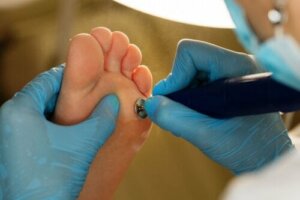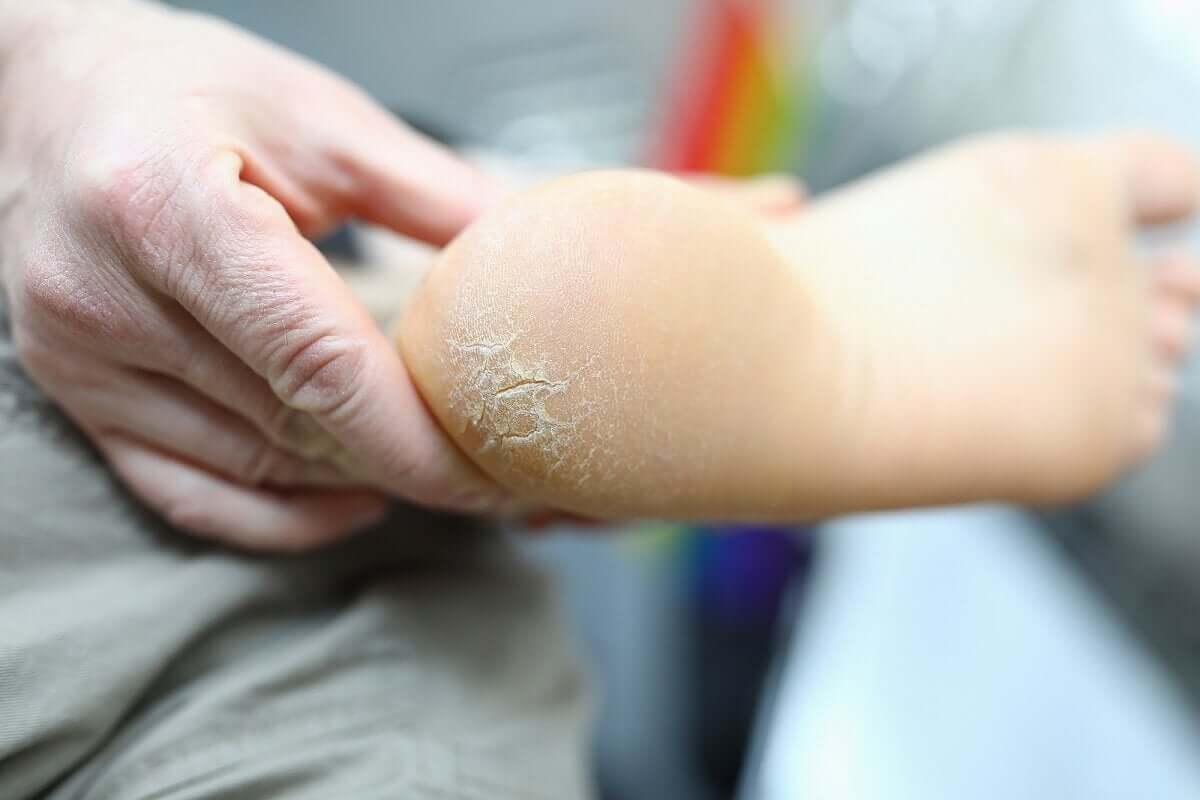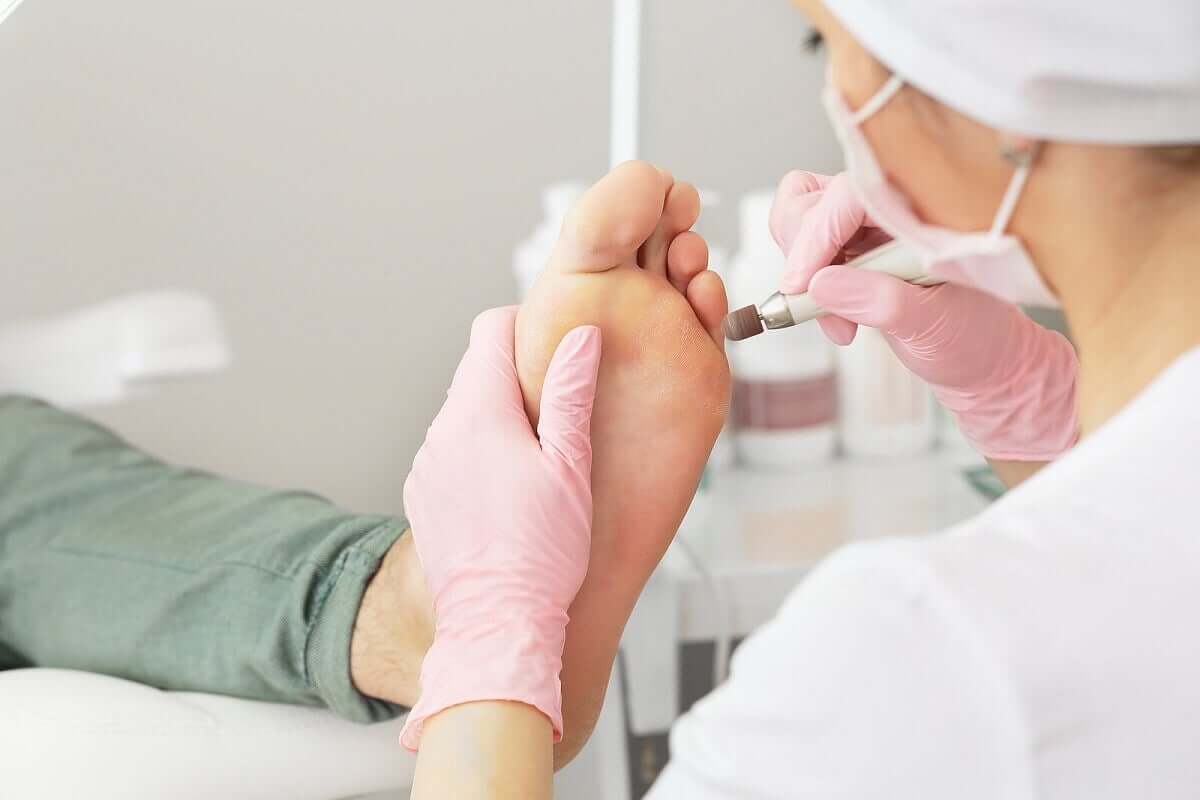Medical Treatment for Calluses on Hands and Feet

Calluses are growths on the outermost part of the skin; calluses usually appear on the hands and feet. They’re also known as “helomas” and are quite an annoying condition. The point is that they don’t only affect aesthetics, they’re also uncomfortable and sometimes lead to injuries.
They also tend to be located between the fingers, which is why they’re popularly known as “chicken eyes”. In any case, they’re all characterized by making the skin look thickened and abnormal.
In addition, these thickenings become scaly and dry. Although they don’t usually cause major discomfort, some people experience pain when the affected area is subjected to pressure. They may even crack and bleed. Fortunately, there’s a medical treatment to improve them. Want to learn more? Just keep reading!
What are calluses and why do they appear?
Calluses are an overgrowth of the horny layer, which is the outermost layer of the skin. This is due to continuous friction or overloading. The consequence of this is a condition called “hyperkeratosis”, which means a hard, thickened area of skin.
The main causes are pressure and friction with an external element. This usually occurs in the feet due to the use of inadequate footwear. In the hands, on the other hand, it’s usually caused by the continued use of an element that generates pressure.
This thickening of the skin has a protective function. The body reacts to pressure and friction, which generates more cells to form this hard layer. Sometimes, calluses also appear due to bunions or other foot deformities.

You may be interested in: 5 Tips to Prevent Your New Shoes from Hurting You
Types of calluses on hands and feet
There are three basic types of calluses. These are as follows:
- Hard calluses. They’re the most common and are characterized by having a compact consistency. They appear more frequently on the feet.
- Soft calluses. They have a rubbery consistency and are more frequent between the toes.
- Vascular and neurovascular calluses. They’re similar to hard calluses, but inside there are blood vessels. Neurovascular calluses have nerve tissue and are usually the most painful.
Diagnosis
Most calluses can be detected with the naked eye or by touch. Thickening and hardness are usually their distinguishing feature. However, it’s always important for a physician to assess the situation as sometimes there are also other underlying problems that need to be treated.
The physician, usually a podiatrist, will perform a thorough examination of the area. If deemed necessary, they’ll order an x-ray or other imaging tests. The goal is to evaluate the condition of the bones and determine if there are any underlying abnormalities.
Medical treatments available for calluses
The main treatment for calluses is to avoid the rubbing or pressure that has caused the problem. It’s important to replace the footwear with a more suitable one or to work with appropriate gloves, if the calluses are on the hands.
Sometimes it’s necessary to use insoles or similar devices to protect the area and prevent new calluses. On the other hand, doctors can perform some other measures, especially if the callus is painful.
Trimming excess skin
The doctor can trim the thickened skin or callus with a scalpel. This is an appropriate measure to remove the callus. It’s important to keep in mind that the health professional should perform this procedure so that it’s done correctly and, therefore, you avoid possible infection.
Medications for calluses
There are over-the-counter 40% salicylic acid patches on the market that are very effective in removing calluses. Ideally, the doctor is the one who indicates if this is the adequate measure for each case and in what way you should receive the treatment.
Sometimes it’s a good option to file the thickened skin with a pumice stone, a nail file or a cardboard file, before applying the patch. It’s also possible that, instead of using the patch, the doctor may recommend a gel with the same substance.
Insoles
Orthopedic and custom-made insoles can be a good alternative for some people. Doctors usually indicate it for those who have some type of foot deformity. They work by preventing rubbing or pressure from footwear.
Surgery
It’s not common, but in some cases doctors must resort to surgery. This occurs when there’s a malformation in the foot or hand, and this makes friction or pressure unavoidable. If an ulceration or infection forms, the doctor may also need to remove the damaged tissue.

Natural supplements against calluses
There are some natural supplements that can also help in these cases. For example, some recommend placing half an onion on the affected area overnight. According to popular literature, the acids in this vegetable soften the callus and facilitate its removal when filed with a pumice stone.
You can do something similar with two grated garlic cloves and a tablespoon of olive oil. Cover with gauze and leave overnight. Repeat this remedy until the calluses disappear.
Another good option is to make an infusion of calendula and mix it with magnesium sulfate, also known as Epsom salts. Then soak your feet in this mixture to soften the calluses. It’s best to do this at night.
Treatment of calluses: what should you remember?
It’s very important to eliminate the cause of calluses on your hands and feet; otherwise, you can treat them over and over again, but then they’ll reappear because the factor that causes them continues to act. Therefore, first of all, you must determine what causes this problem.
You must use pharmaceutical remedies for calluses. Otherwise, the problem can be aggravated. In addition, you can supplement these with some remedies of natural origin. In any case, if in doubt, it’s best to consult a doctor and follow their instructions.
All cited sources were thoroughly reviewed by our team to ensure their quality, reliability, currency, and validity. The bibliography of this article was considered reliable and of academic or scientific accuracy.
- Singh D, Bentley G, Trevino SG. Callosities, corns, and calluses. BMJ. 1996;312(7043):1403-1406. doi:10.1136/bmj.312.7043.1403a
- Castillo, M. D. L. L. M. (2007). El uso del calzado: ¿cuándo, por qué? y sus consecuencias. Revista Mexicana de medicina física y rehabilitación, 19(4), 54-55.
- Esson, M. G., Quiala, M. T., Pérez, A. J. H., de la Cruz, C. S., & Urgellés, A. N. (2014). Plantillas terapéuticas de madera como implemento para el tratamiento y mejoramiento de algunas enfermedades y deformidades de los pies. Revista Información Científica, 87(5), 894-903.
- Martín, A. R., Escalera, B., & Flores, E. S. (1994). Callos y callosidades: tipos y tratamientos. Acofar: revista de la distribución farmacéutica cooperativista, (322), 24-27.
- Hashmi F, Nester CJ, Wright CR, Lam S. The evaluation of three treatments for plantar callus: a three-armed randomised, comparative trial using biophysical outcome measures. Trials. 2016;17(1):251. Published 2016 May 17. doi:10.1186/s13063-016-1377-2
This text is provided for informational purposes only and does not replace consultation with a professional. If in doubt, consult your specialist.








